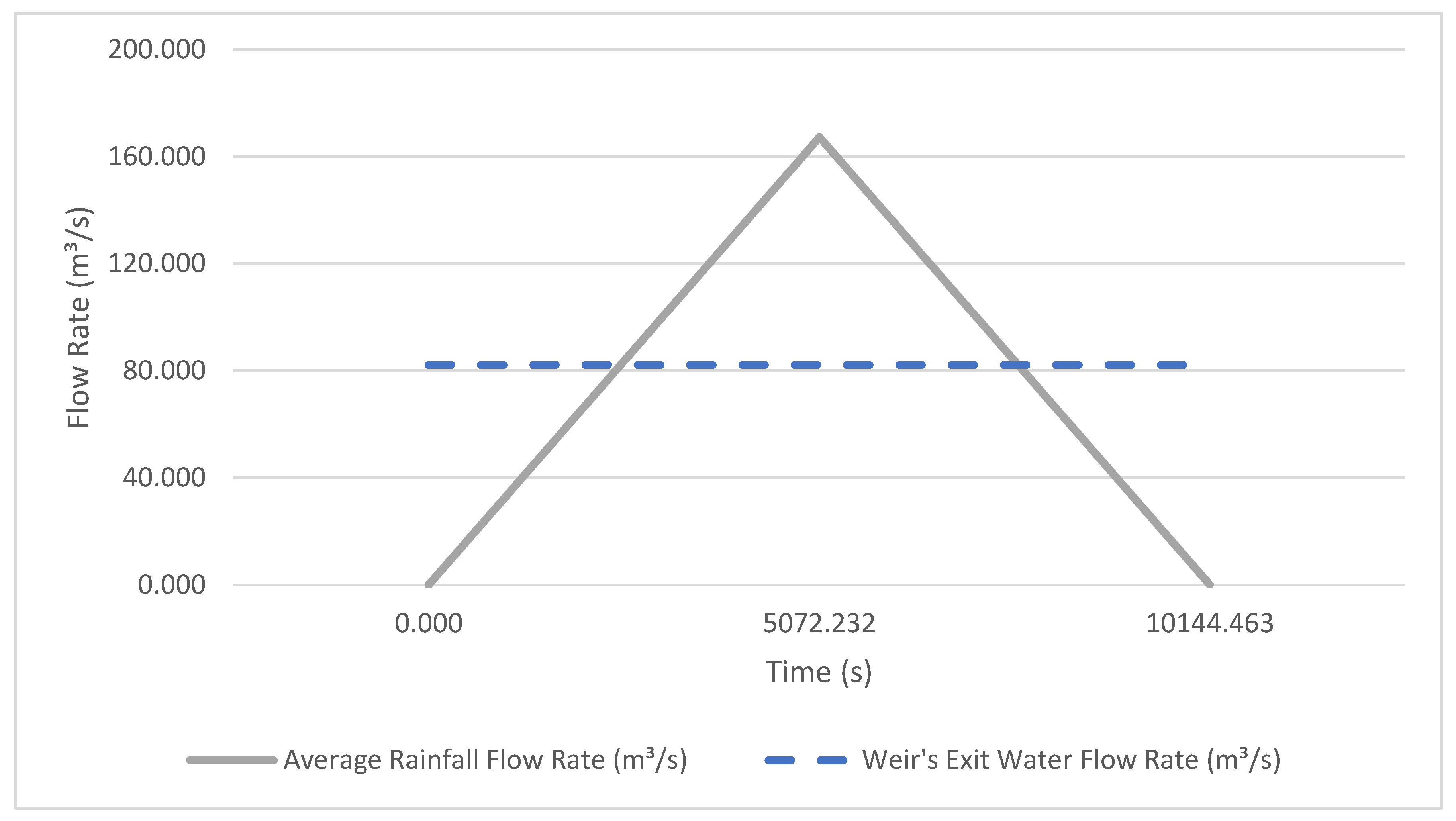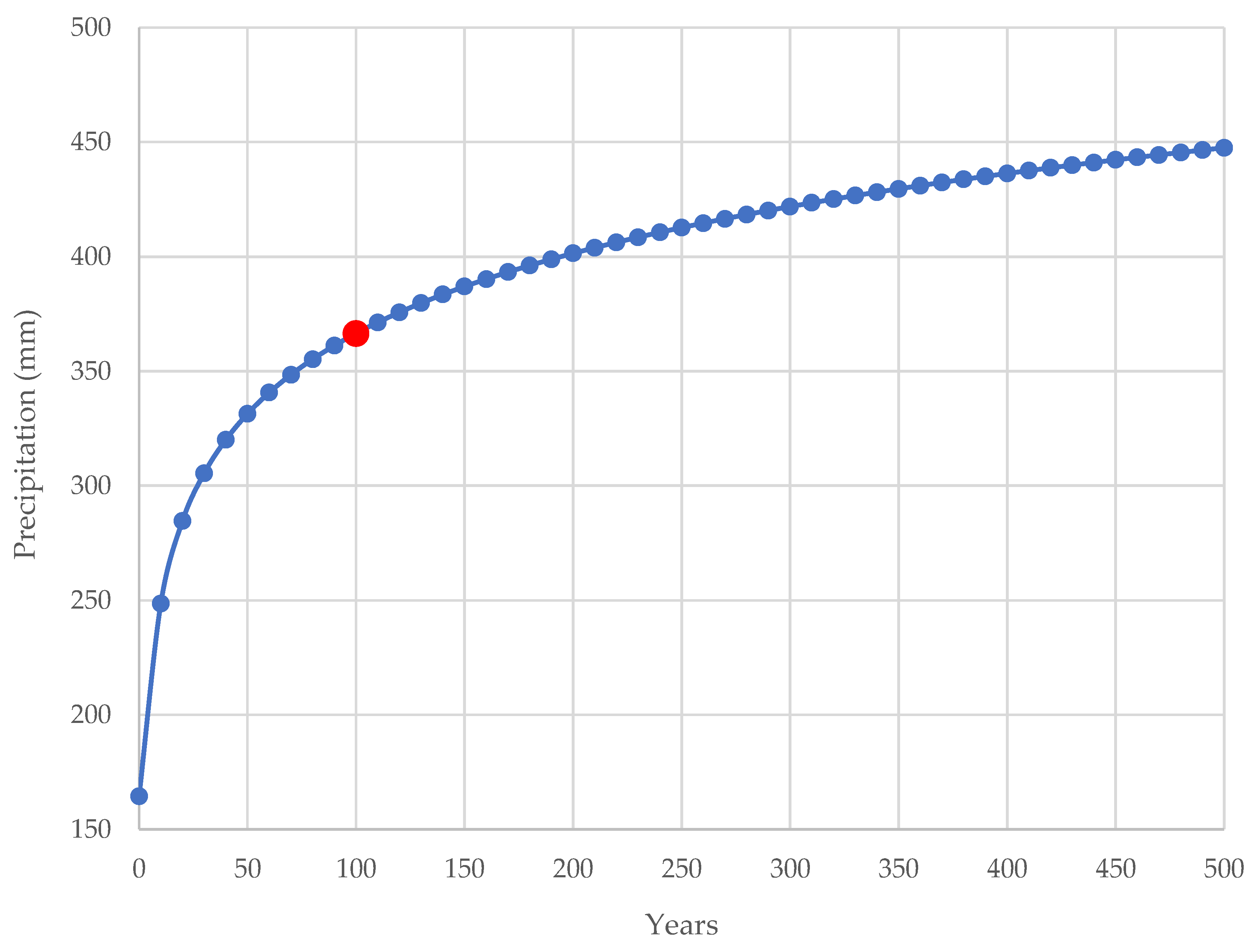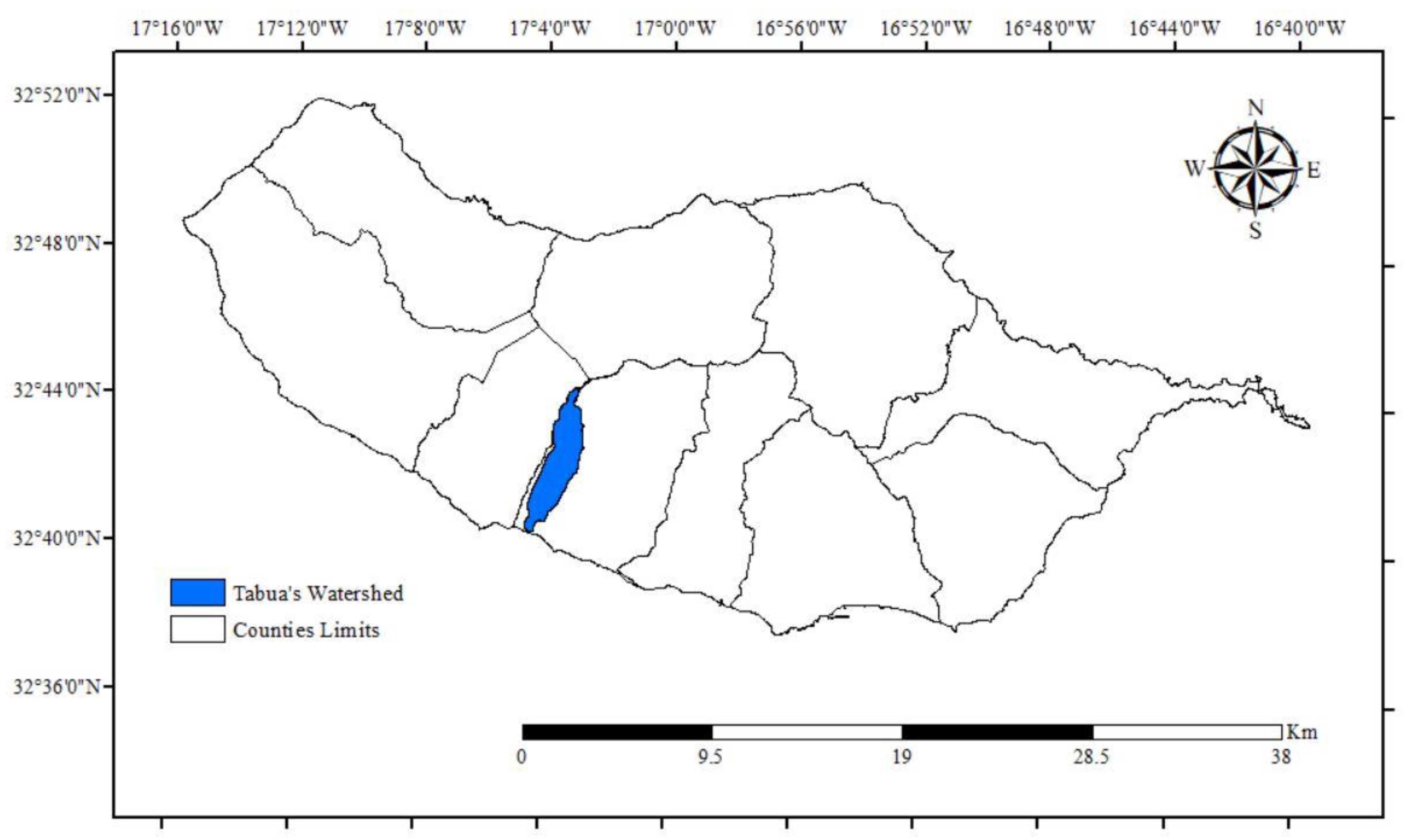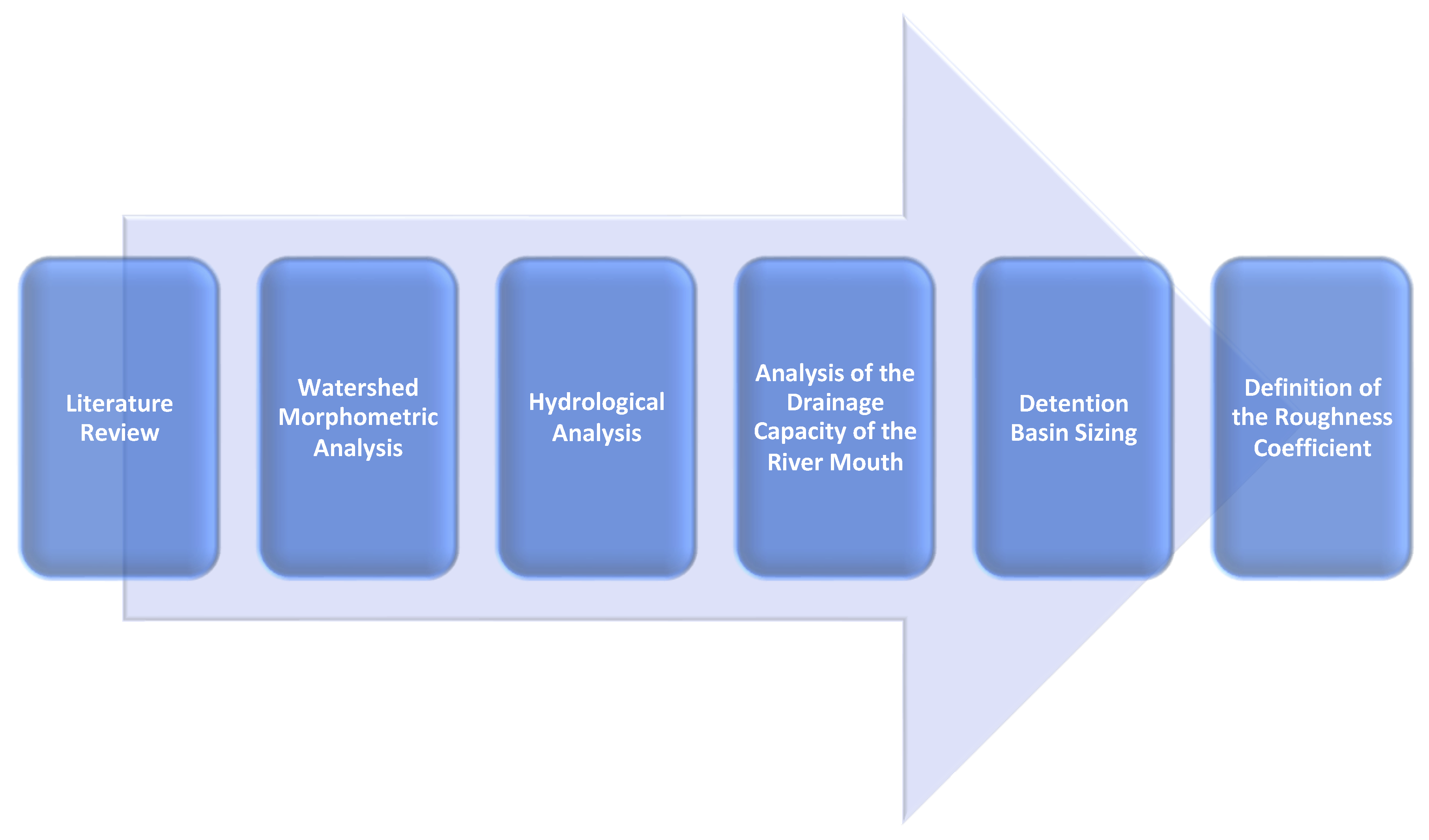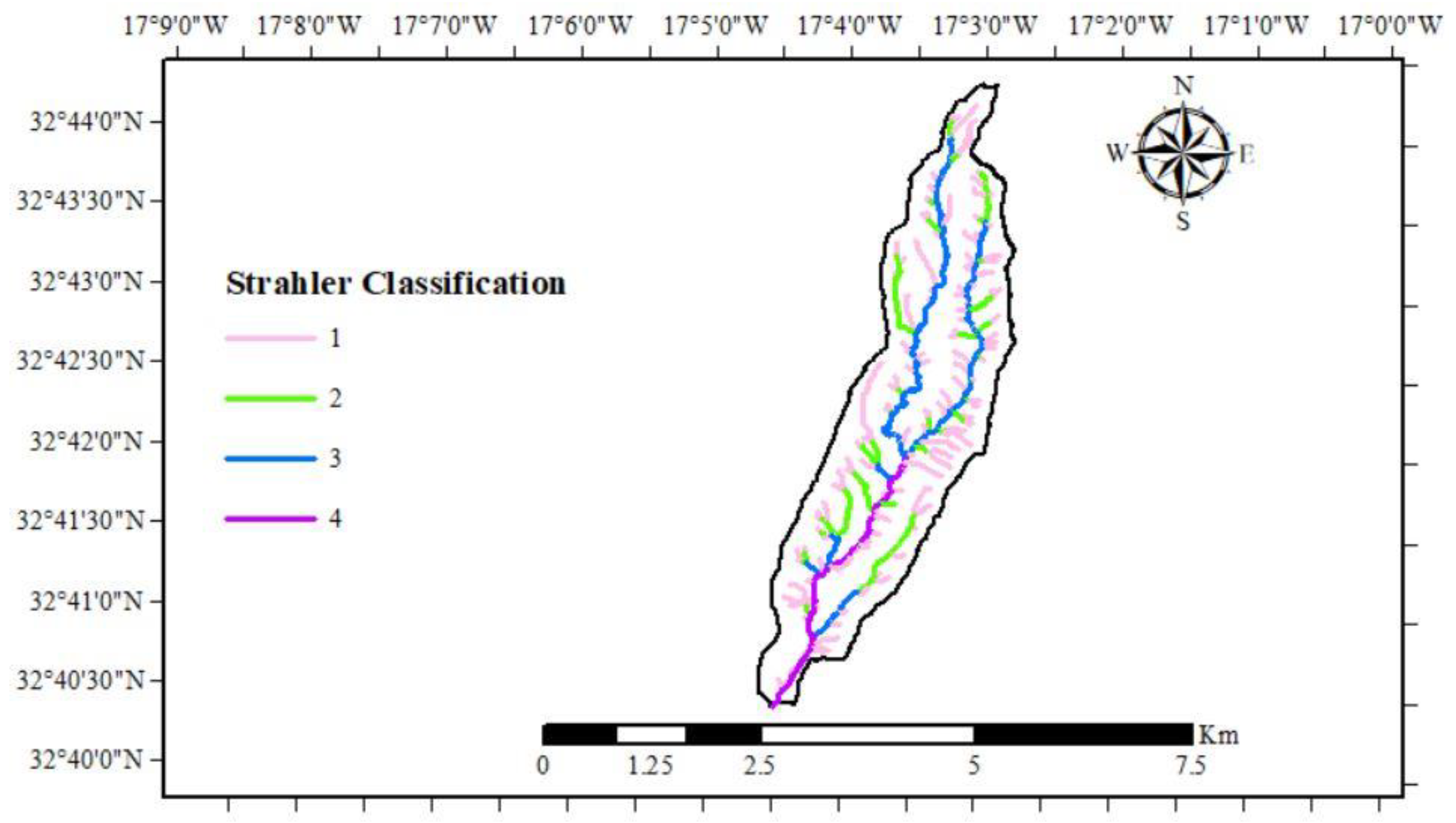1. Introduction
Nowadays, a society’s sustainable development is significantly influenced by aspects such as weather and climate [
1]. For instance, extreme weather conditions are perceived as a risk to the integrity of both the social and economic spheres [
1]. As a consequence of the higher level of climate instability, the incidence and intensity of hazardous hydrometeorological phenomena have been increasing [
2]. Indeed, the changes in land use, the increase in terms of population density, the geological characteristics, and the region where a certain region is located are all aspects that can be seen as major contributing factors to most disasters that occur due to climate change [
3,
4].
In the definition of climate change, one can encompass the variations that occur in terms of the average climatic conditions, either globally or from a regional perspective. It results from the synergy that arises between the variability that is naturally associated with the climate and all the major modifications in terms of the atmosphere’s composition mainly caused by human actions [
5]. Moreover, climate change is currently considered one of the biggest threats to the world [
6]. As the temperature rapidly increases, due to anthropogenic disturbances, both the patterns of rainfall and the hydrological cycle might end up being altered [
7,
8]. These alterations in terms of the climate have the capacity to interfere with elements such as the temperature and the rainfall – especially, the extreme temperature and rainfall events – as previous studies with observed data [
6,
7,
9] and projected future data [
6,
8,
10] have demonstrated. Those rapid changes in climate extremes are believed to originate severe disasters – namely, floods and droughts. Hence, studies on this particular field have gathered massive attention globally as the aforementioned aspects enhance the importance that a correct planning and management of water resources has. Nonetheless, despite being a global phenomenon, extremes’ changes can’t be seen as homogenous across the world; in fact, there are large differences in terms of frequency, temporal and spatial extent across different regions of the globe [
6,
11,
12]. Hence, to provide different perspectives that account for those differences, it’s encouraged for scientists to investigate multiple regions of the world, offering unique perspectives [
6].
In recent times, climate experts have been focusing on mitigating the negative impacts of climate-extremes, especially in urban areas, since those are areas where studies point out to substantial increases in regard to high air temperature extremes [
1,
13]. However, only approximately 10% of the urban areas were affected with an increase in terms of the frequency of precipitation extremes [
1,
13]. The positive relationship that exists between the intensity of daily extreme precipitation and global warming is an evidence-based fact. Indeed, it has been determined that the rate of increase is approximately 7% per degree of global warming [
1,
14]. One other major concern has to do with a scenario where hot and wet extremes meet. For instance, precipitation extremes, when preceded by a heatwave, can have their effects amplified, which ultimately leads to a greater flash-flood risk [
1,
15]. As aforementioned, these significant climate changes are able to affect temperature and rainfall extremes – that has been proven by resorting both to observed data and to simulated future data [
6,
7,
8]. Considering that such abrupt changes end up leading to severe events, namely floods and droughts, studies whose focus has been directed to these extremes received global attention, as the importance of accurately planning and managing water resources increased [
1,
6]. Consequently, decision-makers and policy officials that operate in the field of disaster management, especially, have been encouraged to develop and implement mitigating and preventive strategies regarding the occurrence of floods. This occurred mainly due to the changes that took place in the meteorological and socio-economic fields, which ultimately contributed to an increase in this type of phenomenon’s frequency [
4].
Cities are frequently facing serious and recurring natural disasters, and flooding is an event that can be highlighted. Due to the acceleration of the urbanization process, population and economic activities ended up becoming highly concentrated, which can be translated into more significant social and economic damages from flooding when compared to the pre-urbanization period [
16,
17,
18]. Flooding can be classified as the rising or even the overflowing of a water flow. Just like droughts and hurricanes, for example, floods are classified as a natural and severe phenomenon; nevertheless, they can be influenced by a region’s characteristics, such as the soil type, the vegetation, and the weather [
18,
19]. Because of the huge amount of impacts that this phenomenon causes – in terms of natural devastation, economic and social losses, and, ultimately, human lives – since it occurs in areas of large human presence, floods are considered a “natural disaster” [
19,
20,
21]. Flooding events often result from heavy rainfall and their effects are mostly felt in urban locations that are disorderly occupied and located in hazardous areas. Indeed, the human need for water resources “forced” cities to be built near rivers [
20,
21,
22,
23]. Past civilizations looked to establish their cities in the surrounding areas of rivers because of their need for water; this need arose due to multiple purposes, since irrigation, animal necessity, and to assure a more fertile land [
19]. Therefore, one can conclude that urban areas are more prone to be affected by floods not only due to climate change but also as a consequence of an inadequately conducted urbanization process [
19,
24]. Nevertheless, recent observations point out to an increase in terms of the frequency of flooding disasters mostly because of climate change. In fact, climate change has led to higher levels of annual precipitation and increased runoffs from a hydrological perspective – these two factors, when combined, contribute to a higher risk of flooding [
4]. As floodings tend to become more recurrent, there has been a growing effort to create accurate flood risk maps, in order to sustainably prevent these risks and, therefore, protect both the population and the infrastructure [
4,
25].
Floods are seen as a harmful and recurrent natural disaster that generate obstacles to the socioeconomic development of a significant amount of regions worldwide [
26,
27,
28,
29,
30]. From 1990 to 2016, it is believed that floods all over the globe originated losses of approximately USD 723 billion [
17]. Urban areas are the ones that are more prone to be affected by floods, in part, due to population growth and climate change, but also because of the increasing intensity and recurrence of these events [
31,
32,
33,
34]. By 2030, around 40% of all the cities around the globe will be located in regions where the risk of flooding is high, with such a scenario affecting approximately 54 million people [
35]. Regarding Southeastern Asia, by 2030, 82% of urban areas will be inserted in high-frequency flood zones [
36]. In order to be able to develop accurate risk management plans regarding sustainable land use planning, it is necessary a deep understanding of the relationship that exists between floods and urban growth [
37,
38]. This type of extreme event brings risk mostly to people living either in the watercourses vicinity or in areas with fewer slopes [
19,
20,
21,
22]. Additionally, the hydrological dynamics of floodplains, rivers, and coastal regions can be influenced by processes of both natural and human-induced nature, and that ends up altering aspects such as the surface runoff and the water infiltration process [
19]. Thus, one can find in floods one of the biggest challenges that humanity will have to face in the near future, especially because of their huge capacity to provoke destruction [
39,
40]. In fact, as recent years have already been affected by the climate change, extreme flood events’ frequency has increased, which can be interpreted as a clear and significant threat to humanity [
39,
41,
42].
The flood system has spatial-temporal dynamics, which makes it highly complex, involves uncertainties, and integrates multiple challenges within a system that is responsible for giving rise to complex phenomena [
43]. In regard to flood risk management, research assumes a key role in estimating flood hazards and enhancing people’s understanding of the complex flood risk components, both from an environmental and socioeconomic perspective [
44].
The risk that is associated with floods results from a combination of hazard, exposure, and vulnerability; thus, flood risk management will consist in reducing the damage and/or intensity of the flood [
17,
22,
45,
46,
47]. In recent decades, scientific advancements have led to significant alterations regarding the approach utilized to mitigate the negative impacts of floods. Structural measures to control the impacts of floods (e.g. dikes, embankments, etc.) are being substituted by new and more comprehensive models of flood risk management [
20,
48]. These new approaches consider risk assessment studies – studies that consider flood hazard and exposure/vulnerability factors – to estimate the probabilities and the consequences associated with flood events [
17,
21]. Multiple methodologies have been adopted in order to allow the computation of these indicators. On the one hand, the hazard approaches consider: measurement-based, field surveys [
49,
50], hydrodynamic models [
51,
52], and GIS and Remote Sensing [
17,
20,
21,
22] in linear modeling of flood risk through overlaying component layers with associated analytical hierarchical process (AHP)-based computed weights. On the other hand, the indicators related to land cover might be divided into two different categories: (i) traditional terrestrial mapping [
38,
53]; and (ii) land cover classification, which is mostly built around observations via satellite [
38,
54]. The arise of satellite sensors – for example, Landsat, Satellite Pour Observation de la Terre (SPOT), and Sentinel 2 – has been extremely important to enable a quicker and easier land cover classification, as well as to facilitate the study of land cover evolution. Moreover, remote sensing allows a quicker acquisition of data, when compared to field survey methods, which also end up being more expensive [
55].
The assessment of the risks associated with flooding is a crucial step when defining suitable management strategies [
56]. Over the past few decades, studies have concentrated efforts on developing methodologies for assessing flood risk at multiple scales and considering various goals. Mishra et al. [
57] developed an index to analyze the flood propensity of an Indian river – the Kosi River – which is mostly based on hazard – considering aspects of geomorphologic nature, the distance to the active channel, the slope, and also the levels of rainfall – and on the socioeconomic vulnerability (population and its characteristics, household, and female densities; levels of literacy; alterations in the cover and use of land; existing intersections between roads and the river; road density). In addition to that, Chinh Luu et al. [
58] studied the flood risk’s temporal variations; in order to obtain a deeper knowledge in regard to this phenomenon’s dynamics and, as a consequence of that, to be capable of formulating appropriate strategies of mitigation, this study integrated multiple aspects – the hazard and the level of exposure and vulnerability of a certain region. Dang et al. [
59] delineated the key roles required to enhance flood risk assessment methodologies that aim to support the decision-making process. Flood risk indices were divided by the authors into three components: social–economic, physical, and environmental. Kron [
60] elaborated flood risk indices that considered flooding probability and its hypothetical consequences, the social-economic vulnerabilities of the region, and its environment. Begun et al. [
17] combined the probability of occurring a flood with the losses that the event would eventually bring. Multiple methodologies aiming to study flood propensity were developed in several areas. But they end up being limited in a comprehensive framework that supports decision-makers to get a better perception of the aggravating risk causes. Additionally, the focus of most of these studies lies on assessing the flood propensity at a specific time; however, Penning-Rowell et al. [
61] claims that mitigation measures are more effective when they’re evaluated continuously. Jhong et al. [
17] reinforces the idea that, to diminish the risk of flooding, understanding the level of vulnerability and hazard at different times is of extreme importance; this also is crucial from a land management perspective since it allows a more accurate analysis of the temporal and spatial trends that are more likely to exist in the future [
62].
To assure that a flood study in an urban region will assist in the process of implementing appropriate forecasting and mitigation strategies, it must consider multiple aspects. Indeed, these aspects encompass obtaining topographical data, describing the phenomenological processes that are usually associated with flood currents and their interaction with both structures and infrastructure, in addition to choosing adequate algorithms to solve model equations, which allows obtaining the results [
63]. Analysis of this nature must generate the so-called hazard and risk maps, i.e., maps that show the final representation of results through graphic products [
64].
A major priority regarding the management of urban disasters is to mitigate the negative effects of urban floods [
18,
65,
66]. Since urban floods risk assessment is capable to identify the probabilities and the main causes associated with the flooding phenomenon, it can be perceived as a key element to prevent and reduce the occurrence of urban floods [
18,
67,
68,
69]. Thus, aiming to prevent significant losses, it becomes fundamental to implement methods that diminish the risk of floods. Multiple factors might be pointed out when discussing the level of vulnerability of a certain region to floods – relief characteristics, the compactness coefficient of the watershed, the intensity and distribution of the rainfall, the occupation and use of the soil as well as its types. An approach based on Geographic Information Systems (GIS) enables the determination of the regions that are more susceptible to floods, which can be seen as a great assistance to the decision-making process in this particular field [
19,
70,
71].
Storm sewers, gutters, culverts, tunnels, pipes, detention basins, and other mechanical devices are among the most commonly used measures to control floods [
72]. Moreover, advanced gray infrastructure is utilized in some runoff control methods aiming to guide excess surface flow into disposal and storage sites [
73]. However, considering a climate system that in recent times has been severely affected by extreme weather events, these strategies ended up not being nimble enough to effectively handle large levels of runoff [
74,
75]. To improve urban areas’ capacity to “resist” to floods, different alternative methodologies and concepts have been introduced in different parts of the globe. For instance, the low impact development (LID) in the US [
76], the sustainable urban drainage systems (SUDS) in the UK [
77], the water-sensitive urban design (WSUD) in Australia [
78], or even the “sponge city” in China [
79] are examples of alternative approaches.
A recent report from the European Environment Agency [
80] highlighted that a significant number of European nations and organizations have already worked on policies and laws, both at regional and national levels, to enhance cities’ adoption of mitigation measures to address the effects of climate change, a strategy that is in line the input by the European Strategy on Adaptation to Climate Change. In addition to the fact that extreme events have become more frequent, the increasing apprehension among all stakeholders has originated a significant focus on this matter. Nonetheless, the changes that occur in terms of land use don’t gather that much attention, which may be concerning because, if a soil is sealed, the effects of climatic extremes might end up being amplified [
81,
82].
So, finding new land management strategies assumes a high level of importance, in line with what was outlined by the European Strategy, where it’s indicated the necessity for the member states to define adaptation plans to fight the effects of climate change, on a national, regional, and local scope. It is also important to engage municipalities on climate change and to provide all the support needed to implement adaptation measures locally. In fact, the municipal scale has the highest levels of effectiveness, in part due to the fact that municipalities are responsible for managing land use, through urban planning [
81].
Regarding land planning, two important lines of study arise: (i) the analysis and adoption of mitigation strategies after the events occurred; (ii) the increment in terms of the territory’s resilience, in order to allow it to more easily adapt to the new scenarios that might end up arising as a result of the aforementioned changes and, therefore, mitigate risks that may derive from them, considering that more permeable soils can be translated into soils that are more prepared for absorbing heavy rains [
38,
81].
Consequently, prevention assumes a crucial role in both scenarios and that can be achieved by appropriately planning and designing the territory. The fact is management and solutions end up having multiple approaches and there’s a need to integrate them. Here, planning is particularly relevant as this step focuses precisely on the root causes of the problems as well as on preventive measures [
38,
81].
Based on that, the current study aims to conduct a hydrological analysis focused on this particular region, aiming to estimate the expected peak flow rate, considering a time of recurrence of 100 years; a posteriori, establish a comparison between this value and the drainage capacity that this watershed’s stream mouth possesses. After demonstrating that the mouth’s hydraulic characteristics are not enough to drain the estimated peak flow rate, it became necessary to size a detention basin as a mitigation measure aiming to normalize the flow downstream. The ultimate goal was to allow the mouth to operate normally, considering the dimensions that it currently has. Moreover, this study also focuses on the need for structural actions on the region of the mouth, a measure that, it’s worth saying, wouldn’t implicate significant urban impacts. This structural intervention would be associated with an alteration of the physical features of the stream’s riverbed and walls, namely, the coefficient of roughness. Thus, to increase the drainage capacity, the minimum characteristics of the stream end up being verified, without the necessity for dimensional changes.
3. Results
The values that are presented in this section correspond to the results generated as a result of the application of the aforementioned formulas. Thus, in order to assess the morphometric traits of this watershed’s principal watercourse, it became necessary to conduct an individual analysis, which focused on the parameters presented in
Table 1, establishing correlations with reference values recommended by various authors.
The first parameter analyzed, which is related with the watershed’s area, has a significant level of relevance when studying the water volume drained to the mouth. Moreover, considering its area, a watershed can be classified as: Very Large > 20 km
2; Large > 10 km
2; Medium > 1 km
2 and Small < 1 km
2 [
91]. In line with what the table above illustrates, this watershed can be classified as “Small”, which can be translated into a lower propensity to flooding when compared to larger watersheds. Nonetheless, it’s worth mentioning that reference values tend to be arbitrary; therefore, they may end up differing in accordance with the type of analysis that is being done [
91].
This watershed’s borders have higher altitudes when compared to its central region, as
Figure 5 demonstrates, which indicates a steep slope that will enhance a rapid supply to the main course, originating higher volumes of water in the stream and, ultimately, in the river mouth.
In regard to this watershed’s system of drainage, illustrated in
Figure 6, the presence of numerous watercourses – mostly, medium- or even low-order watercourses that end up supplying the principal watercourse – is associated with a larger drainage capacity. In fact, this indicator can be interpreted as the behavior of a certain area, hydrographically speaking, which has as its key aspect the probability of generating new watercourses. In basins with larger hydric densities, there’s a bigger tendency to generate new watercourses – and, as a consequence of that, these basins usually have a larger number of ephemeral channels [
86,
87].
To conduct the precipitation analysis, it was necessary to resort to the data from the National Information System on Water Resources (SNIRH) [
92], as it gathers data from a period of sixteen years. This data might be observed in
Table A4 and
Figure A2 (daily maximums). Thus, the Gumbel Distribution’s probabilistic processing allowed to obtain the values that are present on
Table 2.
Subsequently, the peak flow rates were calculated using the formulas that were mentioned in the previous section (Equations (16), (17), (18), and (19)), as shown in
Table 3; that was possible because the precipitation intensity for a recurrence time of 100 years had already been determined. Regarding the surface drainage coefficient, the value of 0.500 was utilized in the rational methodology (
Table 4) since the region in which the study is focused can be classified as a peripheral area with commercial buildings. In other words, this value is associated with the parcel of water that usually is drained superficially, that is, half of the total precipitation.
In terms of the river mouth’s capacity of drainage, it became necessary to resort to the Manning–Stickler equation to analyze whether a detention basin would be necessary in this case or not; the results gathered in this process can be found in
Table 6. Nonetheless, it is relevant to point out that the bed and walls of the stream don’t have the same coefficients of roughness. Hence, the river mouth’s capacity of drainage was calculated through a weighted mean, considering the respective coefficients. Regarding the stream walls, since they present a satisfactory condition, n = 0.020; on the contrary, the stream bed is in a poorer condition, with a surface partly covered by vegetation and stones, which implicates n = 0.040 (
Table A1). One other crucial aspect lies on the fact that the river mouth region has a remarkably low scope, which is usually associated with a deceleration of the water flow and a decrease in terms of the capacity of drainage. In order to simulate a critical scenario, it was considered a 0.01 m/m slope in the reference section.
Table 6 shows that both the Giandotti and the Mockus methodologies have exceeded the limit of 85% for the Fill Rate. So, it becomes necessary to define and implement flow control and mitigation measures in the river mouth area. Based on that assumption, the sizing of a detention basin was carried out, taking into account the methodologies referred above, while also considering the spatial and urban limitations associated with the existing infrastructures located in the stream surroundings.
Since the detention basin’s dimensions depend on the exceeding flow, a Cipolletti trapezoid spillway’s size was estimated, aiming to regularize and control the flow that will end up draining downstream. The characteristics of the spillway are listed in
Table 7.
After that, both the Dutch Method and the STH were utilized to estimate the dimensions of the detention basins. These methodologies have as one of their most significant drawbacks the fact that they’re considered simplified approaches, as they don’t consider multiple factors; consequently, the use of these methodologies might end up resulting in an overestimation of this structure. Moreover, aiming to diminish the implementation works’ environmental and urban impacts, the detention basin’s height and width were fixed, as they were set considering the existing cross-section values. Thus, the structure’s length was the only geometric variable; nevertheless, this variable is limited by the main watercourse’s length.
After resorting to the previously mentioned methodologies, it became possible to obtain the results presented by
Table 8.
Lastly, the alteration of the roughness coefficient was also considered since this measure would mitigate the flooding effects while simultaneously keeping the riverbed vegetation intact. So,
Table 9 displays values that are related to the improvement of the conservation level of the riverbed, with the objective of enhancing its drainage capacity by reducing the friction that exists between the covering material and the fluid.
To sum up, the altered walls’ coefficients of roughness are related to the surface with concrete finishing in good condition, notwithstanding the fact that the riverbed maintains its stony and vegetated feature, although in good condition.
Table 10 shows the values associated with these coefficients.
4. Discussion
Since this study’s main objective was to analyze the necessity to implement simplified mitigation measures in the watershed under study, the detention basin revealed to be an efficient measure to control the flow in the river mouth area; this strategy can be classified as a structural measure [
86]. Indeed, the Fill Rate dropped to 59% as a result of this mitigation measure, while, initially, the Fill Rate was superior for any of these methodologies: Forte (82%), Rational (68%), Giandotti (144%), and Mockus (118%). Hence, it has been demonstrated that the detention basin enables the river mouth to operate significantly below the 85% limit that was previously mentioned. In addition to that, this study is in line with the analysis that was undertaken by the Regional Directorate for Territorial Ordering and Environment (DROTA), as
Table 11 demonstrates, which is a positive indicator regarding this study’s level of accuracy.
One of the objectives of this study was to find mitigation measures that didn’t cause significant impacts, either in the waterway or in its surroundings. This occurs due to the fact that natural elements and values located in cities are key for the environmental recovery of an urban region [
96]. Moreover, urban and natural systems are coexistent, which means that their type of management needs to be an integrated one – as it is a regional space requirement and has significant importance for a region’s sustainability [
97,
98]. If not, a disorganized urbanization process might lead to urban voids [
99].
Therefore, the streams’ cross-section dimensions weren’t altered, resulting in length as the only dimensional variable. Considering that fact, the utilization of the Dutch Method originated in oversized results, as the total length of the detention basin surpassed the length that the main waterway possesses. As a result, it would be necessary to modify one of the other dimensions – height, and width. So, in this scenario, the Dutch Method can’t provide a satisfactory level of accuracy for the urban conditions that were imposed.
Regarding the STH method, it could be applied in this case because the detention basin’s total length is shorter in comparison with the main watercourse’s length.
In terms of the roughness coefficient alteration, the final decision was to preserve the riverbed’s stony and vegetated characteristics since the main focus would be enhancing its level of conservation. In addition to that, this decision was also based on the fact that removing the entirety of the sediments, vegetation, and stones located in the riverbed is a strategy that would involve multiple costs (monetary costs, time spent, etc.). As for the walls, frequent maintenance won’t be needed, due to the fact that wear by abrasion would take place in an alluvial channel that has a bigger tendency for draining high volumes of water, in addition to large granular sediments.
The alteration of the roughness coefficient, despite being considered a simple mitigation measure, had satisfactory effects (with the exception of Giandotti’s methodology), which enables the river mouth to avoid working above the filling limit. In fact, the STH method and the alteration of the coefficient of roughness can be adopted simultaneously, and that would lead to a detention basin with a reduced length and, therefore, with an optimized dimension.
Nonetheless, these methodologies are simplified in nature, that is, don’t take into account local specificities. This originates results with an excessive safety margin that will ultimately cause oversized structures.
